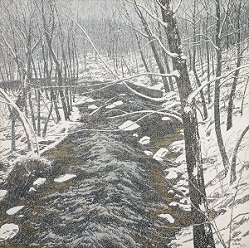Snow has been much in the news lately, which brings to mind one of the perennial favorite artworks in Crystal Bridges’ permanent collection: Neil Welliver’s Snow on Alden Brook. This large painting, measuring 96 × 96 inches, depicts a quiet scene of snowfall in a Maine forest, with hundreds of snowflakes covering the surface of the canvas.
Welliver, born in 1929, found a way of working with landscapes at a time when landscape painting had become what Frank H. Goodyear, Jr., the former director of the Heard Museum in Phoenix, AZ, called “a nostalgic pursuit.” But Welliver wanted to see a new sort of landscape painting develop, one that was “wholly and completely personal, created, though, by a person with a profound sense of the cultural roots and the great styles of Western painting.”
Winter landscapes are generally represented less frequently than other seasonal scenes, perhaps because the leafless trees and white background limit the pallet to monochromatic shades of dark and light. But Welliver excelled at this particular genre, which he began working with in 1983. “I am interested in what the snowflakes do to the natural forms,” he said. Certainly the veil of snow in Snow on Alden Brook, along with the work’s limited pallet, gives the painting a sense of quietness and abstraction: when you’re standing close to the canvas, the image dissolves into abstract Pointillist dots, gradually becoming clearer as you step back from it.
Welliver began his paintings by “hanging out” at the site, becoming so familiar with it that he could recreate the feel of the experience back in his studio. “I look really hard,” he said, “and then I make it up as I go along.” He based his paintings loosely on studies he created outdoors in the Maine woods, in all kinds of weather, but he denied any “macho” reason for this method. “To paint outside in the winter is painful,” he said. “It hurts your hands, it hurts your feet, it hurts your ears…. But sometimes there are things you want and that’s the only way you get them.”
The artist was particularly well known for his unusual manner of working. After developing his initial ideas in small scale, Welliver would sketch the painting in charcoal at full scale on paper which he then stapled to a plain canvas. Next, the artist would trace the lines of the drawing using a “pouncing wheel,” a tool like a pizza cutter with small spikes on the wheel that punctured the paper along the lines of the sketch, leaving a fine tracery of dots that provided a guideline that Welliver would elaborate upon in creation of the final work.
Finally, the artist began slowly and deliberately building the work, starting in the upper left corner and moving across and down bit by bit in sections. He never returned to a completed section to change or add to it. Author and artist Maurice Grosser described Welliver’s process as being “exactly as though he were lowering an upside down window shade to reveal a landscape already behind it.”
The art critic John Ashbery said of Welliver’s snow paintings that “nothing is left to chance, yet what emerges is a powerful, subliminal projection of an ephemeral moment: you can smell and taste the cold, and the damp penetrates your bones even as you wonder at the magisterially orchestrated and ordered precision of the complex surface.”
Welliver said: “I am very interested in the idea of the spectator entering a picture … to, in fact, not see the picture as an object but really actively enter into it…. in a psychological sense.”
Certainly Snow on Alden Brook makes you feel a bit as if you are standing on the threshold of an open door, with the landscape beckoning for you to step into it. I invite you to visit Crystal Bridges’ 1940s to Now gallery and experience this magical painting for yourself.
Read more about it The information and quotes in this post were drawn from several books and catalogs on Neil Welliver’s work available in Crystal Bridges’ Library: a great place to come to enjoy terrific views of Crystal Bridges’ architecture and read all about some of your favorite artists in the Museum’s collection.
Welliver. Introduction by John Ashbery; text by Frank H. Goodyear, Jr. New York : Rizzoli, [c1985]. Neil Welliver: Recent Paintings. New York : Marlborough Gallery, 1985






